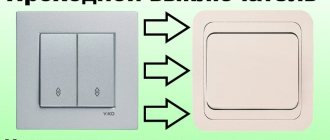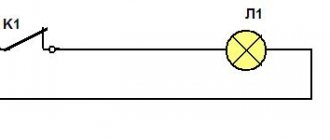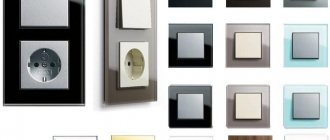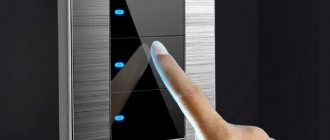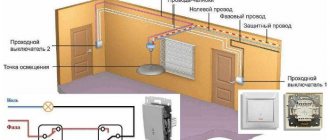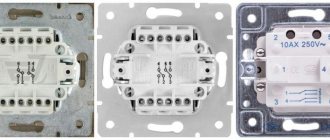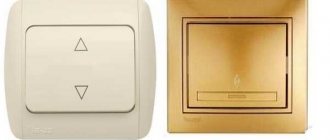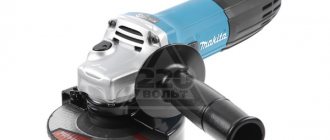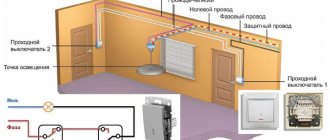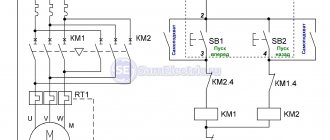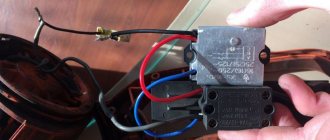The connection diagram for a light switch with one key will allow you to accurately cope with this process. In fact, a switch is a primitive device that is located on the ceiling and connected to the electrical wiring. The products differ in shape and design, but they all have the same internal layout.
Today we will look at the process of connecting a single-key device if repair or replacement is necessary. In order to avoid any questions, we have to study several installation methods.
Wiring diagram for a light switch with one key
What is a pass-through switch used for?
The main feature of a pass-through switch is the ability to turn on the light in one place, go to another and turn off the light there.
So conveniently and comfortably, any number of people can move in any direction and sequence. That is why the device is called a pass-through device. In practice, this is very convenient to go through, for example:
- from the garage to the house down the street;
- follow the long corridor;
- climb the stairs from the first floor to the second;
- turn on the light at the bedroom door, walk to the bed and turn it off.
In all four cases, a pair of pass-through switches will help us out. The convenience of using such devices in large apartments and houses is especially noticeable. To control lighting in more complex combinations with several lamps and control points, pass-through switches with different numbers of keys and internal circuits are used.
Types of Electrical Switches
The range of electrical devices presented on the Russian market does not allow us to list all the names of this product, but absolutely all devices are divided into the following modifications:
- Hidden installation - this type of electrical switches allows you to preserve the interior of the room and place an element of electrical fittings inside the wall. One of the disadvantages of this type of electrical fittings elements is the need for chiselling of walls, which significantly increases the time spent on installation work.
- External installation - used mainly in bathhouses and utility rooms. This type of switches is much more convenient to operate and repair, but is significantly inferior to hidden devices in aesthetics.
Installation of these devices takes a little time, but each type has its own characteristics and installation sequence. How to install a light switch according to all the rules will be described in detail below.
Pass-through type switch design
Externally, a main switch is no different from a regular switch, except for the presence on the key of a conventional image in the form of two triangles and a diagram of the device on the back side of the dielectric base.
Inside the pass-through switch there are three contacts: two fixed and one movable (changeover), driven by the external key of the device. The changeover contact has two possible operating positions - on one of the fixed terminals. By pressing a key, the movable contact moves from one terminal to another, breaking one circuit and closing the second.
This design feature of the pass-through switch is the basis for a network design in which one lighting fixture can be controlled from two different locations. The neutral and grounding wires from the distribution box are connected to the lighting device, and a break is made in the phase conductor with two pass-through switches, between which two alternative lines are laid.
How to connect several lamps to a single switch.
If you need a single-key switch to turn on several lamps at once, for example, 3 lamps, then in principle there are no special differences in implementing this connection diagram. All you need:
connect the neutral working wire " N
N
wire coming from the junction box ;
connect the phase wire “ L
L
coming from the switch .
The correct diagram for connecting a switch with one key to a chandelier with several lamps is shown in Figure No. 4.
Fig. 4 - diagram of connecting a single-key switch to a chandelier with several lamps.
Operating principle of a pass-through switch
Unlike the usual models of two- and one-key switches for turning on lighting, pass-through switches provide two on positions. To operate the circuit, two pass-through switches are used, with which you operate the lighting lamps.
A schematic diagram of the operation of such an electrical circuit is shown in the figure below:
Figure 1: operating principle of a pass-through switch
As you can see, in the diagram, the phase wire is connected from the electrical wiring to the switches, and the neutral wire is led directly to the lamp or other lighting equipment. If you trace the connection from the distribution box, the phase is supplied to the input of the first pass-through switch. Next, two independent wires connect the terminals A and B of the first device to the terminals of the same name of the second switch. From the output terminal of the second switch, the phase is supplied to the lamp output. The second terminal of the lamp is connected by the neutral wire.
Of course, the above connection diagram requires additional cable costs to connect the switches to each other, but its functionality more than justifies it. Due to its design features, such a switch does not break the circuit in any position, so it is more correct to call it a switch.
In everyday life, due to the use of such switches on staircase landings to disconnect flights from different points, they are also called marching switches.
If you decide to implement such a scheme at home or in the office, but do not want to overpay for a pass-through switch, it can also be made from a cheaper two-key device. Next, we will look at two techniques that will allow you to make a pass-through switch with your own hands.
Types of switches for home use
Each manufacturer produces different models of switches, which differ both in shape and internal structure. However, several main types should be distinguished.
Table 1. Types of switches by switching principle
| View | Description |
| Mechanical | Devices that are easy to install. Instead of the usual button, some models have a lever or cord. |
| Sensory | The device works at the touch of your hand, and you do not need to press a key. |
| With remote control | This design is equipped with a special remote control, which comes included, or a sensor that responds to movements around. |
The most popular is the first option, which is installed everywhere. Moreover, such switches have become in demand since the very beginning of the appearance of the electrical circuit. The second option is less popular, especially in our country. The third option is a modern model, which is gradually displacing outdated switches from the market.
Installing a motion sensor in a structure is advisable both from the point of view of energy savings and home safety. For example, if you install a structure at the entrance, residents will notice if intruders break into the apartment.
Switch with additional lighting
Depending on their design features, there are devices with one or several buttons (on average, for standard electrical appliances, switches with two or three buttons are used). Each button is responsible for turning on and off a separate circuit.
So, if several lamps are installed in one room at once: the main chandelier, spotlights, sconces, then it would be advisable to install a design with three buttons.
In addition, no less popular are devices with two buttons, which are installed in all apartments without exception. Most often they are needed for a chandelier when there are many light bulbs.
Find a more detailed diagram of connecting a chandelier to a two-key switch in a special article.
Depending on the installation method, there are internal and external switches. The first option is installed in the apartment, because such structures look aesthetically pleasing. For safety during installation, a special box is installed, which is called a socket box.
Connection diagram
Built-in switches are used when there is electrical wiring hidden in the wall. Overhead devices are mounted in the presence of external conductors. In this case, the connection diagram has no fundamental differences.
Where is the switch installed?
Differences between pass-through and traditional switch
The difference between a pass-through and a regular switch (rear view)
The switches are no different in appearance. The internal structure of a conventional one is equipped with one input and output. Can have up to three keys, allowing you to control multiple lighting sources. Most often they are installed near the entrance to the room. The connection is made using two terminals.
A classic checkpoint has two exits and one entrance. In this case, the electric current is not interrupted, but is redirected to any other output. There is a diagram underneath the product body. The single-key pass-through is equipped with three-wire switching and three terminals with copper contacts. This is a switch that redirects the current to other areas.
By design, installation method and type of control, switches can be:
- keyboards;
- push-button;
- sliders;
- traction;
- toggle switches.
They are also classified depending on voltage and current, degree of protection, and climatic conditions in which they are installed.
It is important not to confuse an electrical appliance with a changeover or crossover device. On the pass key there is a vertical triangle, in the rest it is located in the horizontal direction.
Parameters of a single-key switch
The main properties include:
- Voltage range from 220V to 250V;
- General then cat 5A to 16A;
- Protected from dirt, moisture and other adverse factors;
- Resistant to mechanical stress;
- It does not stop functioning when temperatures change.
When purchasing, carefully examining the packaging, you will notice the marking 10A 250V. These data tell us that this switch can be used at values no higher than 10 amperes and a power of 250 watts.
Reworking the device
The process of converting a simple switch into a walk-through is accessible to everyone with their own hands. Its appearance is no different from its brother. It can have 1 key, 2 or more. The difference between these devices is visible only from the inside. The pass-through serves to switch circuits, so it is more correct to call it a switch. Most often at home you have to use a regular single-key main switch. In large rooms, a device with several keys is sometimes required.
The modification consists of adding a contact: instead of 2 you need to put 3. How to connect a pass-through switch to the network? A three-core cable must be laid between a pair of devices. The phase always goes to the switch, zero to the light fixture. Nowadays, photo relay circuits are made using KT315B transistors or Q6004LT. Our task is to make a pass-through switch from an ordinary marching switch with our own hands.
Application area
A single-key switch serves as a convenient mechanism for remote control of both one light source and a complex.
You can use the switch:
- To supply energy to home lamps;
- For remote control of street lamps;
- To turn on a set of lamps;
- To activate the fan.
Switches are installed in the most convenient places for use. In residential premises, switches are located in the area of doorways, at the level of the lowered hand, so as not to make unnecessary physical movements. Previously, the switch was installed at the level of a person’s shoulder, approximately 150cm-160cm from the floor.
Connection diagram of switches for controlling one light source from several places
To be able to control the lighting circuits, we need the following materials:
- distribution box with a diameter of 80 mm;
- 2 pieces of pass-through switches;
- flexible cable type PVSng or VVGng 3x1.5;
- 5 pcs of WAGO type terminal clamps for 2–3 contacts (or a soldering iron with tin and rosin);
- 2 pcs socket boxes for concrete (plasterboard).
The connection diagram for a pass-through switch made from the above materials will be as follows:
As we see in the above photo, to control lighting using pass-through switches, the neutral power wire in the terminal box is connected to the first output of lamps No. 1 and No. 2. The phase wire of the supply circuit in the distribution box is connected to terminal No. 1 of pass-through switch No. 1. The remaining two outputs of switch No. 1 are connected in the box to terminals No. 2 and No. 3 of switch No. 2, respectively. Next, pin No. 1 must be connected to the second free end of the lighting lamps.
The above circuit will allow you to fully control the lighting system, however, the above circuit does not protect a person from electric shock. For these purposes, the following connection diagram for the pass-through switch is used:
As we can see from the above photo, the main difference between the two schemes is the use of a three-core cable, which, in addition to phase and neutral, also contains a third grounding conductor. It allows, if the insulation in equipment or cable and wire products is damaged, to divert the resulting potential to the ground loop and cause the circuit breaker to trip.
Why do you need a crossover switch along with 2 pass-through switches?
Two groups of lamps. When considering it, the following nuances can be noted: All work is performed only with the circuit de-energized. Therefore, let's look at how to properly connect a switch along with a lighting fixture, a circuit breaker and a junction box. Switches from the French company Legrand are distinguished by their wide range and reliability.
When choosing a location, you need to take into account the location of all the elements of the circuit and choose the shortest path to connect them. The main convenience of this design is that, if necessary, you can make them yourself.
There are many places in an apartment or house where the ability to turn off the lights from several points is useful. Using a screwdriver, unscrew the screws and remove the plastic cover.
Assembly of Legrand Valena Information! Wiring diagram for walk-through switches ABB Zenit: How to connect wiring diagram walk-through switches ABB Basic Wiring diagram for walk-through switches Anam To the main page xnacmllexpcq1j.
If the rooms are not too far from each other, then it is better to make all connections in one junction box. This is very convenient if you are planning a designer renovation or simply do not want to re-decorate the room.
But there are often cases when this method of controlling lamps is inconvenient. How to connect a two-key pass-through switch
Related article: Electrical wiring repair
Connection diagram for a pass-through switch with 2 places
The circuit of a pass-through switch from two places is carried out using two pass-through single-key devices that work only in pairs. Each of them has one contact at the entry point, and a pair at the exit point.
Before connecting the pass-through switch, the connection diagram clearly displays all the stages; you should de-energize the room using the appropriate switch located in the control panel. After which it is necessary to additionally check that there is no voltage in all wires of the switch. To do this, use a special screwdriver.
Helpful advice! A similar check must be performed at the installation sites of switching devices.
To complete the work you will need: flat-head, Phillips and indicator screwdrivers, a knife, side cutters, a level, a tape measure and a hammer drill. To install switches and lay wires in the walls of the room, appropriate holes and grooves must be made in accordance with the device layout plan.
Unlike conventional switches, pass-through switches have not two, but three contacts and can switch the “phase” from the first contact to the second or third
Wires must be laid at a distance of at least 15 cm from the ceiling. They can be placed not only in a hidden way, but also placed in trays or boxes. This installation makes it possible to quickly carry out repair work in case of cable damage. The ends of the wires must be inserted into installation boxes, in which all connections are also made using contactors.
Placement - convenience and safety
Before installing the switch, you should consider the most convenient location for installation and subsequent use. The most advantageous area is located near the entrance doors (from the side of the door handle), but there may be exceptions (for example, next to the head of the bed).
Before drawing up a wiring project, it is better to look at the official document - PUE (electrical installation rules), which regulates some of the nuances of installation. For example, clause 7.1.48 states that the switch must be located at least 60 cm from the shower stall, and clause 7.1.50 allows it to be installed no closer than 50 cm from the gas pipeline.
As can be seen from the installation diagram, the distance from the doors to the installation point must be at least 10 cm, and to the floor - at least 90 cm
The installation of control devices in bathrooms and saunas is prohibited; they must be taken outside the room (usually into the corridor).
Changeover switches - lighting control circuit from 3 places
But what if you want to control one lighting from three or more points. That is, there will be 3, 4, etc. switches in the circuit. It would seem that you need to take another pass-through switch and that’s it.
However, a switch with three terminals will no longer work here. Since there will be four connected wires in the junction box.
Here a changeover switch, or as it is also called a cross, cross, or intermediate switch, will come to your aid. Its key difference is that it has four exits - two from below and two from above.
And it is installed precisely in the gap between two passageways. Find in the junction box two secondary (not main) wires from the first and second pass-through switch.
Materials and tools
Before installing the light switch, stock up on the necessary materials and tools. If you are going to do everything yourself, then you will need not only electrical installation tools, but also construction tools.
First you need to punch a hole in the wall. Suitable for this purpose:
- Bulgarian. With its help you can make a square hole in the wall, but that's okay. After inserting the socket box, cover the remaining space around it with a solution of alabaster or plaster.
- A hammer drill with a special bit for concrete. I would like to say right away that with the help of such a tool you can make a wonderful, even hole in walls made of cinder block, brick, foam concrete, plaster, or aerated concrete. If the wall is concrete, then first the future hole is marked with such a crown. Then install the drill on the hammer drill and drill many small holes close to each other along the intended contour. Next, alternate between a drill and a chisel, knocking out the inside of the intended hole. There is an option to purchase a diamond-coated crown; it will cope with the concrete wall itself, but this is a very expensive pleasure.
- A regular drill with a special wood bit or a screwdriver will help you make a neat hole in plasterboard walls.
To secure the socket box in the hole you will need:
- container for mixing the solution;
- plaster (alabaster);
- water;
- putty knife.
To install the switching device itself, you will need:
- Plastic or propylene socket box.
- Single key switch.
- Indicator screwdriver.
- Knife for stripping wire cores.
- Two-core wire (cross-section 2.5 mm2).
- Insulating tape.
- Flat and Phillips screwdrivers.
Also, a wire must be laid in grooves to the installation site of the switch. To make these furrows, you will need a chisel with a hammer or a power tool (grinder, wall chaser).
Disadvantages of pass-through devices
You should always check the circuit before connecting. The input and output contacts of the changeover switch can be located differently
The position of the keys does not allow you to determine whether the system is turned off or on. For example, it may not be possible to immediately understand whether the lights are turned off or a light bulb has burned out. It is impossible to control a lighting device from different places at the same time. A large number of connected devices means a lot of twists in the junction box. Connection errors force you to reassemble the entire circuit.
The pass-through switch has many functionalities. But to connect it, you need to purchase another device. The number of connecting wires also increases, which increases the overall cost of the system. An ordinary switch has a relatively low price, but loses in functionality.
Switches for small lighting fixtures
Single-key switches for various lamps are installed directly on the cord from the lamp. This method increases the safety of use. And it greatly simplifies use; there is no need to disconnect the device from the network.
The switch is very compact and consists of a contact group; when the position of the key changes, it supplies or disconnects the current supply. Such switches are suitable for a power of 4A. For small lighting fixtures, this switch performs its function perfectly.
Connection errors
Many people make a mistake at the stage of searching and connecting the common terminal in the pass-through switch. Without checking the circuit, they naively believe that the common terminal is the one with only one contact. They assemble a circuit in this way, and then for some reason the switches do not work correctly (they depend on each other).
Remember that on different switches the common contact can be anywhere!
And it is best to call it, what is called “live”, with a tester or an indicator screwdriver.
Most often, this problem is encountered when installing or replacing pass-through switches from different companies. If everything worked before, but after replacing one circuit the circuit stopped working, it means the wires were mixed up.
But there may also be an option that the new switch is not pass-through at all. Also remember that the lighting inside the product cannot in any way affect the switching principle itself.
Another common mistake is incorrectly connecting crossovers. When both wires are placed from pass-through No. 1 to the upper contacts, and from No. 2 to the lower ones. Meanwhile, the cross switch has a completely different circuit and switching mechanism. And you need to connect the wires crosswise.
Firm
Manufacturer country:
- Bticino. Italy
- Simon, Fontini. Spain
- Werkel. Sweden
- Hegel. Norway
- TDM Electric, Svetozar, DKS. Russia
- Mavel. Viko. Lezard. Türkiye
- Legrand. France
- Schneider Electric, ABB, Wessen, Gira. Germany
Manufacturers provide switches with a variety of designs, in different colors and shapes. Everyone will be able to choose the appropriate option to suit their taste.
